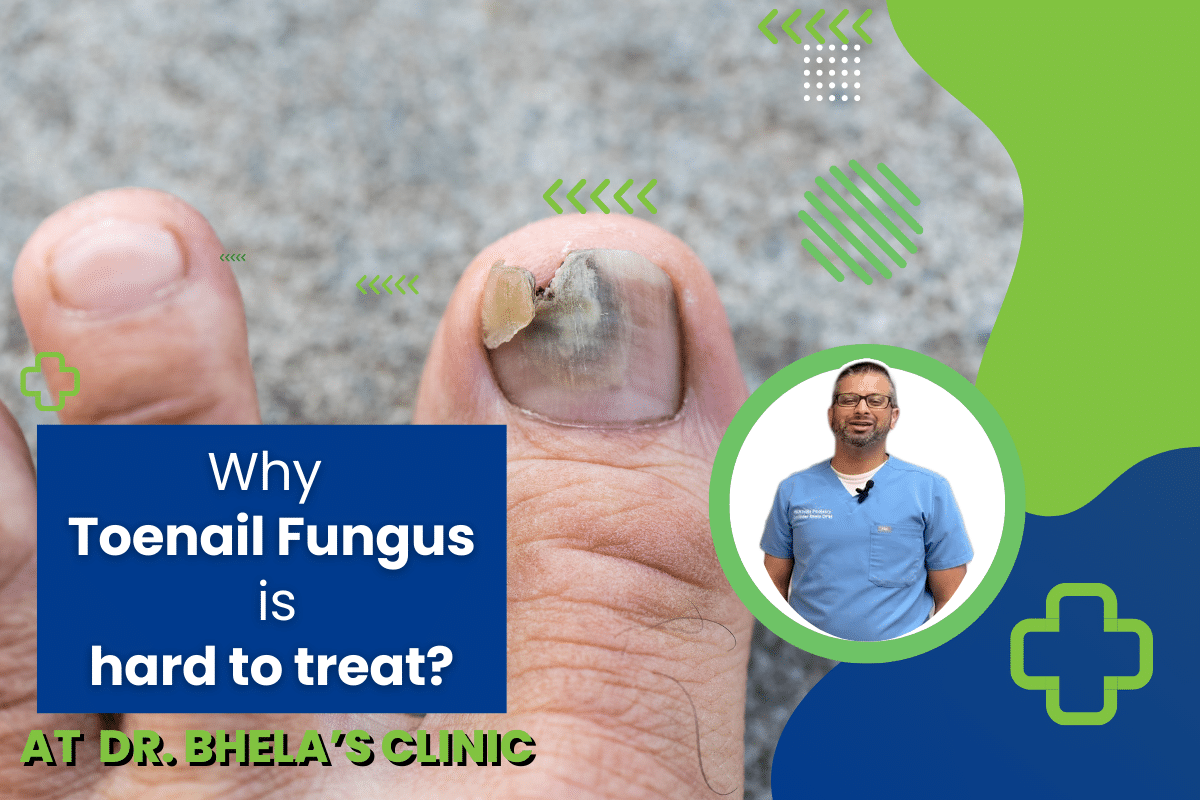Why Toenail Fungus is Hard To Treat?

Toenail fungus is quite common. According to this study, it accounts for about 90% of the toenail infections worldwide. It occurs when fungus enters between the nail bed and the toenail. Additionally, shoes’ damp and warm environment offers an excellent living environment for toenail fungal growth.
Toenail fungus affects the nail and foot’s appearance and causes cosmetic problems to the individual. Toenail fungus can look very displeasing to the eye. Treating toenail fungus can be challenging since the condition is persistent, and the fungus usually lives below the toenail.
In this blog, we will explore toenail fungus, why it is hard to treat, some treatment options, and how you can prevent it.
What Is Toenail Fungus?
This infection is caused by a dermatophyte fungus and usually starts as a yellow or white spot under the toenail tips. Fungal infections are more common in toenails because they are usually placed in moist, warm, and dark shoes, an environment where fungus thrives.
As the toenail fungus infection grows, the nail begin to crumble at the edges, thicken, and discolor. When not treated, the infection can spread to other toenails, skin, and even fingernails.
Why is Toenail Fungus So Hard To Cure?
Many toenail fungus can be successfully treated with direct contact through an over-the-counter fungicide, like in the case of an athlete’s foot. However, it can sometimes be hard to cure. But why is this so? This difficulty exists due to the nature of the nail. The location of the fungus infection makes it hard to get beneath the protective nail and treat the fungus.
It thrives under the toenail. Sometimes, the fungus gets in between the toenail and the nail bed, sits on top of the nail, or grows under it. The toenails act as a protective mechanism for the toes and offer enhanced grip. They are made to be durable and strong; however, our nail offers a protected and safe environment where toenail fungus can live.
Since the nail isn’t porous, getting enough medications with high concentrations to eliminate it isn’t easy. Sometimes, fungus infections can enter the cell that makes new nails, and it can be quite difficult to treat when infected. Additionally, toenails don’t have much blood flow, making the body’s immune system find it hard to eliminate.
How To Treat Toenail Fungus Infection
Treating toenail infections depends on the type of fungus that infected you and the severity of the infection. Usually, the first thing is to consider a consultation with your podiatrist or doctor to examine the treatment options and suggest the best steps to ensure the fungus doesn’t grow back. Also, early treatment is crucial as this might affect the success rate. If your toenail is not thick yet, then it shows you have a mild infection, meaning it might be easy to treat. Some of the available treatment options include;
1. Laser therapy treatment
Toenail Fungus treatment with laser therapy is a treatment method for treating serious cases of fungus infection. It is a new and proven non-invasive treatment that offers no side effects, downtime, or discomfort common with lasers. Using low-level laser light for treatment, this method usually needs at least four 12-minute sessions directed to the infected area for a mild infection. In severe toenail fungus infection, experts highly recommend additional sessions directed to the infected area. It uses a lunula laser that is non-thermal, pain-free, effective, and safe without risks and side effects when compared to other heat-based lasers. It also doesn’t affect healthy tissue when directed at the infected nail and fungal tissue. Laser therapy has been reported to be 70% effective for mild to moderate fungus.
2. Clear Nail Program
Clear nail program involves alternative treatment options that have no toxic medication, no sedation, and non-invasive treatment. Our unique combination of FDA approved treatment, backed by research, is the best way to deal with toenail fungus. By using a special laser with a combination of unique treatment, this treats toenail fungus at the highest level. However, you must first consult with your doctor and undergo an evaluation to know the right approach for you and customize your healing process. The treatment length usually differs per patient, but results can be seen within months. Our clear nail program has 90% success rate for all level of fungus severity from mild to severe toenail fungus.
3. Topical Treatment
These are treatments where the doctor prescribes anti-fungal creams to remove the fungus. The medications are applied directly to the nail. This gradually eliminates the infection with time or till the nail regrows. First, you soak the infected nails and rub the cream into the affected area. They usually work best after thinning the nail. The process involves the medication penetrating layers of the nail to the fungus beneath while helping regrow the infection-free nail, which replaces the affected part. However, this treatment method is very effective when combined with oral treatments. Topical medication has roughly a 17% success rate for mild to moderate fungus.
4. Oral Medications
This is the most common treatment for fungal nail infections. The tablets are taken for about three months to make sure the affected nails regrow and turn normal. They are quite safe but are not meant for everybody since they have some side effects. Many studies have shown that long-term usage of oral antifungal drugs can affect the liver and even affect other medications, making it quite hard to keep using them. Consulting with your doctor ensures you are regularly monitored and recommends the right drugs to treat the infection. Oral medication is about 50% success for mild to moderate fungus. However, the success rate goes lower for severe fungus.
5. Toenail Removal
This is the last ditch effort when other treatments prove ineffective. The doctor surgically removes the infected nail using local anesthetic. However, after the surgery, there is an accompanying antifungal therapy, ensuring the fungus doesn’t return when the new nail grows. Toenail fungus removal procedure has been reported to have a 50% success rate.
Conclusion
Toenail infection is a common infection that can be easily treated when it is mild. However, in severe cases where oral medication fails, several potential solutions exist for toenail infections. You must speak with an experienced doctor about the right treatment for you. The longer a toenail infection, the more likely it gets hard to treat. Suppose you want to learn more about toenail fungus infection or consider the best treatment for toenail fungus. The website above has every answer you require.
Related Questions
1. What if toenail fungus is not responding to treatment?
When toenail fungus does not respond to at-home treatment, it is best to consult with Restore Podiatry for an evaluation. The doctors will examine your nails to determine the right treatment option for you. Skin scraping might be done to determine the type of fungus that caused the infection.
2. What can I do when toenail fungus doesn’t go away?
Studies have shown that combining antifungal pills and applying medicines to the nails is more effective than using either of the treatments alone. However, if you have a severe case and treatment doesn’t work, your doctor might suggest best laser therapy to eliminate the infection.
3. What can permanently kill toenail fungus?
Laser therapy has a higher chance of eliminating toenail fungus. It is a non-invasive method that uses low-level laser light to treat toenail fungus. The procedure is painless and requires four 12-minute sessions.
